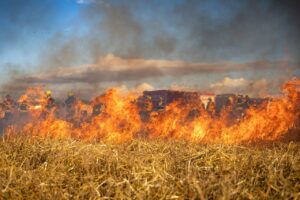Particulate matter (PM2.5) from wildfire smoke can be several times more harmful to human respiratory health than PM2.5 from other sources, such as car exhaust, according to a new study published in the journal Nature Communications.
The researchers from the University of California looked at 14 years worth of hospital admission data and compared this to PM2.5 exposure to wildfire smoke.
In order to isolate wildfire-produced PM2.5, the researchers defined it as exposure to strong Santa Ana winds with fire upwind. The Santa Ana winds drive the most severe wildfires and tend to blow wildfire smoke towards populated coastal regions.
The researchers found that a 10 microgram-per-cubic meter increase in PM2.5 attributed to sources other than wildfire smoke was estimated to increase respiratory hospital admissions by 1%. The same increase, when attributed to wildfire smoke, caused a 1.3 to 10% increase in respiratory admissions.
As of now, there is not a consensus as to why wildfire PM2.5 is more harmful to humans than other sources of particulate pollution.
However, the researchers have said that if PM2.5 from wildfires is more dangerous to human lungs than that of ambient air pollution, the threshold for what is considered safe levels of PM2.5 should reflect the source of the particles, especially during the expanding wildfire season.
The lead author of the study Rosana Aguilera said: ‘There is a daily threshold for the amount of PM2.5 in the air that is considered acceptable by the county and the Environmental Protection Agency (EPA).
‘The problem with this standard is that it doesn’t account for different sources of emission of PM2.5.’
Co-author, Tom Corringham added: ‘As conditions in Southern California become hotter and drier, we expect to see increased wildfire activity.
‘This study demonstrates that the harm due to wildfire smoke may be greater than previously thought, bolstering the argument for early wildfire detection systems and efforts to mitigate climate change.’
Photo Credit – Pixabay
















Leave a Reply